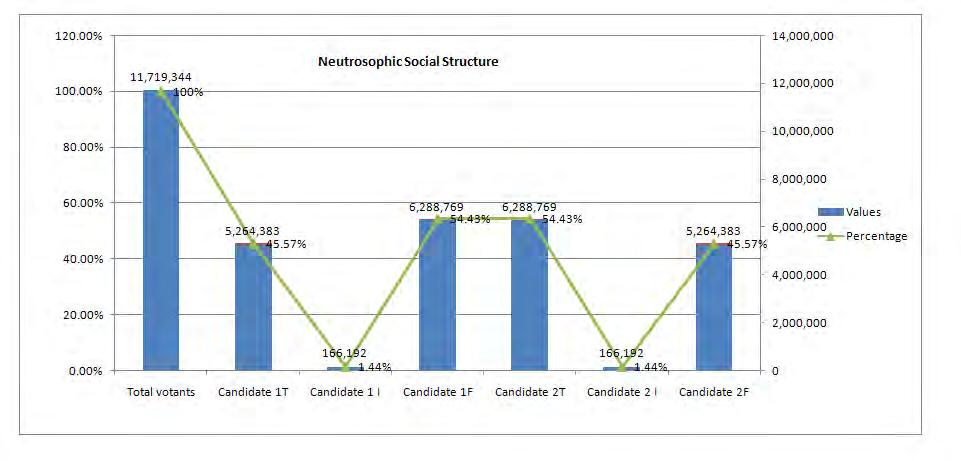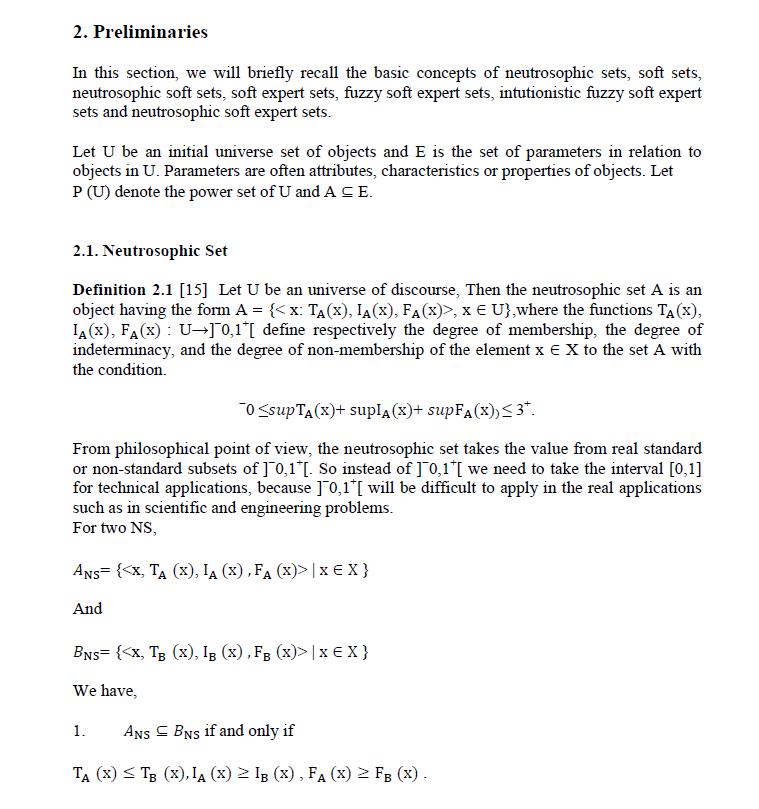
9 minute read
A Critical Path Problem in Neutrosophic Environment
Mai Mohamed, Mohamed Abdel-Baset, Florentin Smarandache, Yongquan Zhou
Advertisement
Mai Mohamed, Mohamed Abdel-Baset, Florentin Smarandache, Yongquan Zhou (2017). A Critical Path Problem in Neutrosophic Environment. In Neutrosophic Operational Research, vol. I, eds.: Prof. Florentin Smarandache, Dr. Mohamed Abdel-Basset, Dr. Yongquan Zhou, 167-174
Abstract
The Critical Path Method (CPM) is one of several related techniques for planning and managing of complicated projects in real world applications. In many situations, the data obtained for decision makers are only approximate, which gives rise of neutrosophic critical path problem. In this chapter, the proposed method has been made to find the critical path in network diagram, whose activity time uncertain. The vague parameters in the network are represented by triangular neutrosophic numbers, instead of crisp numbers. At the end of chapter, an illustrative example is provided to validate the proposed approach.
Keywords
Neutrosophic Sets; Project Management; CPM; Score and Accuracy Functions.
1 Introduction
Project management is concerned with selecting, planning, execution and control of projects in order to meet or exceed stakeholders' need or expectation from project. Two techniques of project management, namely Critical Path Method (CPM) and Program Evaluation and Review Technique (PERT) where
developed in 1950s. [1] The successful implementation of CPM requires clear determined time duration for each activity. Steps involved in CPM include [2]:
• Develop Work Breakdown Structure of a project, estimate the resources needed and establish precedence relationship among activities. • Translate the activities into network.
• Carry out network computation and prepare schedule of the activities. In CPM, the main problem is wrongly calculated activity durations, of large projects that have many activities. The planned value of activity duration time may change under certain circumstances and may not be presented in a precise manner due to the error of the measuring technique or instruments etc. It has been obvious that neutrosophic set theory is more appropriate to model uncertainty that is associated with parameters such as activity duration time and resource availability in CPM. This chapter is organized as follows: In section 2, the basic concepts neutrosophic sets are briefly reviewed. In section 3, the mathematical model of neutrosophic CPM and the proposed algorithm is presented. In section 4, a numerical example is illustrated. Finally, section 5 concludes the chapter with future work.
2 Preliminaries
In this section, the basic definitions involving neutrosophic set, single valued neutrosophic sets, triangular neutrosophic numbers and operations on triangular neutrosophic numbers are outlined. Definition 1. [3, 5-7] Let �� be a space of points (objects) and ��∈��. A neutrosophic set �� in �� is defined by a truth-membership function ����(��), an indeterminacy-membership function ����(��) and a falsity-membership function ����(��).����(��), ����(��) and ����(��) are real standard or real nonstandard subsets of ]0, 1+[. That is ����(��):��→]-0, 1+[, ����(��):��→]-0, 1+[ and ����(��):��→]-0, 1+[. There is no restriction on the sum of ����(��), ����(��) and����(��), so 0− ≤ sup ����(��) + sup ����(��) + sup ����(��) ≤3+.
Definition 2. [3, 8] Let �� be a universe of discourse. A single valued neutrosophic set �� over �� is an object having the form ��={〈��, ����(��), ����(��), ����(��)〉:��∈��}, where ����(��):��→[0,1], ����(��):��→[0,1] and ����(��):��→[0,1] with 0≤ ����(��)+ ����(��)+ ����(��)≤3 for all ��∈��. The intervals ����(��), ����(��) and ����(��) denote the
truth-membership degree, the indeterminacy-membership degree and the falsity membership degree of �� to ��, respectively. For convenience, a SVN number is denoted by ��= (��, b, c), where ��, ��, ��∈ [0, 1] and ��+��+��≤3.
Definition 3. [4, 5]Let �� ̃ ,�� ̃ , �� ̃ ��[��,��] and ����,����,��������such that ���� ≤���� ≤ ���� . Then a single valued triangular neutrosophic number, �� ̃ =〈(����,����,����); �� ̃ , �� ̃ ,�� ̃〉 is a special neutrosophic set on the real line set ��, whose truth-membership, indeterminacy-membership, and falsity-membership functions are given as follows:
(��2 −��+ �� ̃(��−��1)) (��2 −��1)
(��2 ̃(��−��1))
(��2 −��1)
where �� ̃ ,�� ̃ and �� ̃ denote the maximum truth-membership degree, minimum indeterminacy-membership degree and minimum falsity-membership degree respectively. A single valued triangular neutrosophic number �� ̃ =〈(����,����,����); �� ̃ , �� ̃ ,�� ̃〉 may express an ill-defined quantity about ��,which is approximately equal to ��.
Definition 4. Let �� ̃ =〈(����,����,����); �� ̃ , �� ̃ ,�� ̃〉and �� ̃ = 〈(����,����,���� ); �� ̃ , �� ̃ ,�� ̃〉 be two single valued triangular neutrosophic numbers and be any real number. Then, �� ̃+ �� ̃ =〈(���� +���� ,���� +����,���� +����); �� ̃ ˄ �� ̃ , �� ̃˅ �� ̃ , �� ̃ ˅ �� ̃〉 �� ̃ − �� ̃ =〈(���� −���� ,���� −����,���� −����); �� ̃ ˄ �� ̃ , �� ̃˅ �� ̃ , �� ̃ ˅ �� ̃〉
���� ����
3 Critical Path Method in Neutrosophic Environment and the Proposed Algorithm
Project network is a set of activities that must be performed according to precedence constraints determining which activities must start after the completion of specified other activities. Let us define some terms used in drawing network diagram of CPM: • Activity: It is any portion of a project that has a definite beginning and ending and may use some resources such as time, labor, material, equipment, etc. • Event or Node: Beginning and ending points of activities denoted by circles are called nodes or events. • Critical Path: Is the longest path in the network. The CPM in neutrosophic environment takes the following form: A network N= 〈��,��,�� ̃〉, being a project model, is given. E is asset of events
(nodes) and A⊂��×�� is a set of activities. �� ̃ is a triangular neutrosophic number and stand for activity duration. To obtain crisp model of neutrosophic CPM we should use the following equations: We defined a method to compare any two single valued triangular neutrosophic numbers which is based on the score function and the accuracy function. Let �� ̃ =〈(��1,��1,��1 ), �� ̃ , �� ̃ ,�� ̃ 〉 be a single valued triangular neutrosophic number, then
S(a ̃)=
1 16[a1 +b1 +c1]×(2+ a ̃-a ̃-a ̃) (4)
and
A(a ̃)=
1 16[a1 +b1 +c1]×(2+ a ̃-a ̃ + a ̃)
(5) It is called the score and accuracy degrees of �� ̃ , respectively. The neutrosophic CPM model can be represented by a crisp model using truth membership, indeterminacy membership, and falsity membership functions and the score and accuracy degrees of a ̃, using equations (1), (2), (3) and (4), (5) respectively.
Notations of CPM solution:
�� ̃ �� ��=Earliest occurrence time of predecessor event i, �� ̃ �� ��= Latest occurrence time of predecessor event i, �� ̃ �� ��=Earliest occurrence time of successor event j, �� ̃ �� ��= Latest occurrence time of successor event j, �� ̃ ���� ��/Start= Earliest start time of an activity ij, �� ̃ ���� ��/Finish=Earliest finish time of an activity ij, �� ̃ ���� �� /Start=Latest start time of an ���� ��activity ij, �� ̃ ���� �� /Finish= Latest finish time of an activity ij, �� ̃ ���� = Duration time of activity ij, Earliest and Latest occurrence time of an event: �� ̃ �� ��=maximum (�� ̃ �� �� +�� ̃ ����), calculate all �� ̃ �� �� for jth event, select maximum
value.
�� ̃ �� ��=minimum (�� ̃ �� �� −�� ̃ ����), calculate all ���� �� for ith event, select minimum
value.
�� ̃ ���� ��/Start=�� ̃ �� �� , �� ̃ ���� ��/Finish=�� ̃ �� �� +�� ̃ ���� , �� ̃ ���� �� /Finish=�� ̃ �� �� , �� ̃ ���� �� /Start=�� ̃ �� �� −�� ̃ ���� , Critical path is the longest path in the network. At critical path, �� ̃ �� ��=�� ̃ �� ��, for all i, and don't care of the value of ,,. Slack or Float is cushion available on event/ activity by which it can be delayed without affecting the project completion time. Slack for ith event =�� ̃
�� �� −�� ̃ �� ��, for events on critical path, slack is zero. From the previous steps we can conclude the proposed algorithm as follows: Step1: To deal with uncertain, inconsistent and incomplete information about activity time, we considered activity time of CPM technique as triangular neutrosophic number. Step 2: Draw CPM network diagram. Step 3: Determine floats and critical path, which is the longest path in network. Step 4: Determine expected project completion time.
4 Illustrative Examples
To explain the proposed approach in a better way, we solved numerical example and steps of solution are determined clearly.
1.1. Numerical Example 1
You are given the following data for a project: Table 1. Input data for neutrosophic cpm.
Activity Immediate Predecessors
A (1-2) B (1-3) C (2-4) D (3-4) ----------A B
E (4-5) C,D
Time (days)
Step 1: Neutrosophic model of project take the following form: N= 〈��,��,�� ̃〉, where E is asset of events (nodes) and A⊂��×�� is a set of activities, �� ̃ is a triangular neutrosophic number and stand for activity time. Step 2: Draw network diagram of CPM.
Fig.1. Network diagram of CPM Determine earliest start/finish of each activity.
line. Determine latest start/finish of each activity. Step 3: Determine critical path, which is the longest path in the network. From Fig.1, we find that the critical path is B-D-E and is denoted by red
Step 4: Calculate project completion time. The neutrosophic time of project completion = (12, 19, 24; 0.6, 0.4, 0.4)tA +tC +tG +tJ days. To determine crisp value of project completion time we will use Eq.4, then the expected time of project completion in deterministic environment = 12 days.
5 Conclusion
Neutrosophic set is a generalization of classical set, fuzzy set and intuitionistic fuzzy set because it not only considers the truth-membership and falsity- membership but also an indeterminacy function which is very obvious in
real life situations. In this chapter, we have considered activity time of CPM as triangular neutrosophic numbers. In future, the research will be extended to deal with different project management techniques.
References
[1] J. Lewis. Project Planning, Scheduling & Control, 4E: McGraw-Hill Pub. Co., 2005. [2] H. Maciej, J. Andrzej, & S. Roman. Fuzzy project scheduling system for software development. Fuzzy sets and systems, 67(1), 101-117,1994. [3] Abdel-Basset, M., Mohamed, M. & Sangaiah, A.K. J Ambient Intell Human Comput (2017). DOI: https://doi.org/10.1007/s12652-017-0548-7. [4] Mohamed, Mai, et al. "Neutrosophic Integer Programming Problem." Neutrosophic Sets & Systems 15 (2017). [5] I. M. Hezam, M. Abdel-Baset, F. Smarandache. Taylor Series Approximation to Solve Neutrosophic Multiobjective Programming Problem, Neutrosophic Sets and Systems. An International Journal in Information Science and Engineering, Vol. 10, pp. 39-45, 2015. [6] N.. El-Hefenawy, M. Metwally, Z. Ahmed, I. El-Henawy. A Review on the Applications of Neutrosophic Sets. Journal of Computational and Theoretical Nanoscience, 13(1), 936-944, 2016. [7] M Abdel-Baset, I. Hezam, F. Smarandache, Neutrosophic Goal Programming. Neutrosophic Sets & Systems, vol. 11, 2016.





